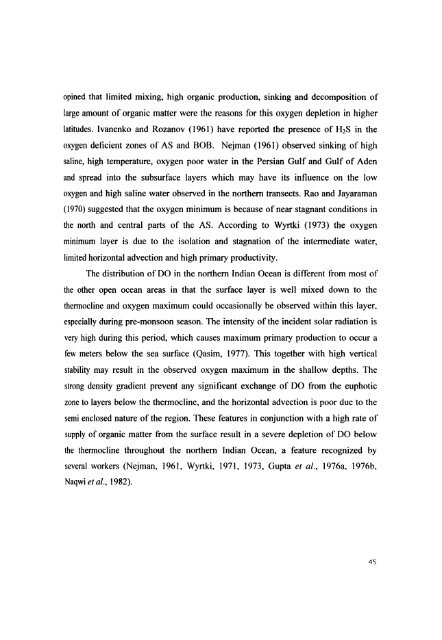L - Cochin University of Science and Technology
L - Cochin University of Science and Technology
L - Cochin University of Science and Technology
You also want an ePaper? Increase the reach of your titles
YUMPU automatically turns print PDFs into web optimized ePapers that Google loves.
opined that limited mixing. high organic production. sinking <strong>and</strong> decomposition <strong>of</strong><br />
large amount <strong>of</strong> organic matter were the reasons for this oxygen depletion in higher<br />
latitudes. Ivanenko <strong>and</strong> Rozanov (1961) have reported the presence <strong>of</strong> H 2S in the<br />
oxygen deficient zones <strong>of</strong> AS <strong>and</strong> BOB. Nejman (1961) observed sinking <strong>of</strong> high<br />
saline. high temperature. oxygen poor water in the Persian Gulf <strong>and</strong> Gulf <strong>of</strong> Aden<br />
<strong>and</strong> spread into the subsurface layers which may have its influence on the low<br />
oxygen <strong>and</strong> high saline water observed in the northern transects. Rao <strong>and</strong> Jayaraman<br />
(1970) suggested that the oxygen minimum is because <strong>of</strong> near stagnant conditions in<br />
the north <strong>and</strong> central parts <strong>of</strong> the AS. According to Wyrtki (1973) the oxygen<br />
minimum layer is due to the isolation <strong>and</strong> stagnation <strong>of</strong> the intennediate water.<br />
limited horizontal advection <strong>and</strong> high primary productivity.<br />
The distribution <strong>of</strong> DO in the northern Indian Ocean is different from most <strong>of</strong><br />
the other open ocean areas in that the surface layer is well mixed down to the<br />
thennocline <strong>and</strong> oxygen maximum could occasionally be observed within this layer,<br />
especially during pre-monsoon season. The intensity <strong>of</strong> the incident solar radiation is<br />
very high during this period. which causes maximum primary production to occur a<br />
few meters below the sea surface (Qasim. 1977). This together with high vertical<br />
stability may result in the observed oxygen maximum in the shallow depths. The<br />
strong density gradient prevent any significant exchange <strong>of</strong> DO from the euphotic<br />
zone to layers below the thennocline. <strong>and</strong> the horizontal advection is poor due to the<br />
semi enclosed nature <strong>of</strong> the region. These features in conjunction with a high rate <strong>of</strong><br />
supply <strong>of</strong> organic matter from the surface result in a severe depletion <strong>of</strong> DO below<br />
the thermocline throughout the northern Indian Ocean. a feature recognjzed by<br />
several workers (Nejman. 1961, Wyrtki, 1971. 1973. Gupta et al .• 1976a, 1976b,<br />
Naqwi et al .• 1982).<br />
45

















